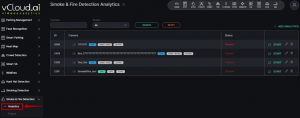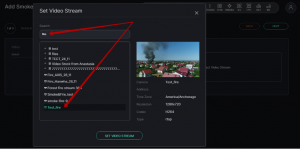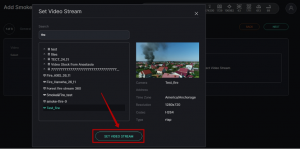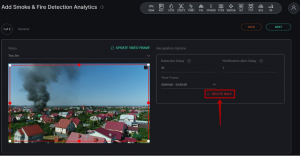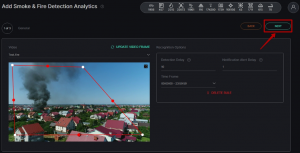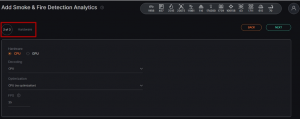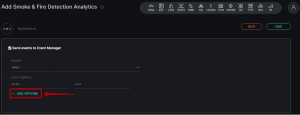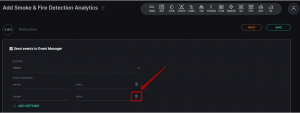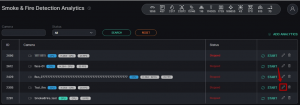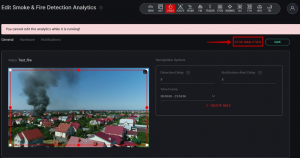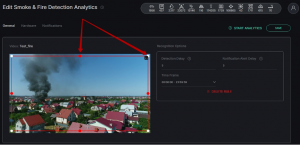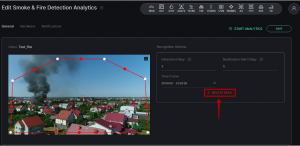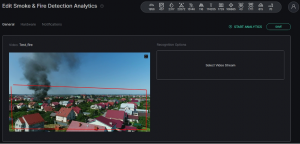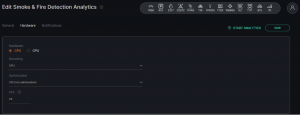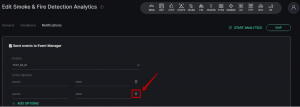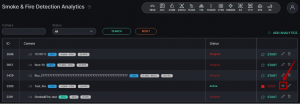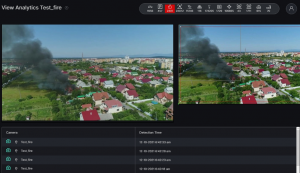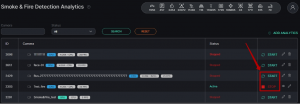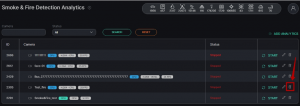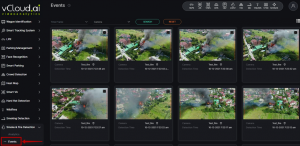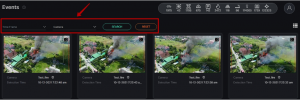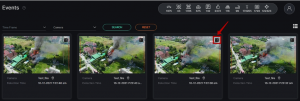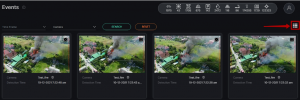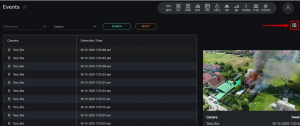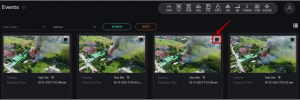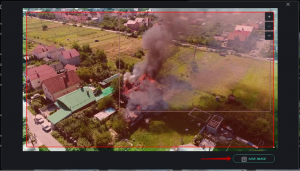Difference between revisions of "VCloud.ai Smoke and Fire Detection VCA"
| (One intermediate revision by the same user not shown) | |||
| Line 24: | Line 24: | ||
|- | |- | ||
|Operating system | |Operating system | ||
|Ubuntu | |Ubuntu 20.04 | ||
|} | |} | ||
| Line 269: | Line 269: | ||
[[File:K74.png|none|thumb]] | [[File:K74.png|none|thumb]] | ||
= Events = | = '''Events''' = | ||
In order to view the cases of detection of smoke and fire sources, select the Smoke & Fire Detection in the left menu and pass into the Events section. | In order to view the cases of detection of smoke and fire sources, select the Smoke & Fire Detection in the left menu and pass into the Events section. | ||
[[File:K76.png|none|thumb]] | [[File:K76.png|none|thumb]] | ||
Latest revision as of 20:33, 13 November 2023
Main functionality
- Recognition and notification of the appearance of smoke or an open fire source.
- Data storage on the occurrence of smoke or fire at the objects of observation.
Product Description
The Smoke & Fire Detection module is designed to register and promptly respond to the occurrence of smoke and fire in the territories or inside objects under surveillance.
| Parameter | Recommended value |
| CPU | Intel Core i5-5575 or higher |
| RAM | 2 GB RAM |
| GPU | NVIDIA 1030 |
| Places for archive | up to 3GB per day (~4.5k detections ) |
| Operating system | Ubuntu 20.04 |
Analytics
To open the Smoke & Fire Detection analytics, select Smoke & Fire Detection in the left menu and pass to the Analytics section.
In the Analytics section, you can customize analytics. The page displays a list of analytics with the status and the ability to add, edit, view, or delete analytics.
There is a search field at the top of the page. Here you can filter analytics by the following parameters:
| Field name | Description |
| Camera | Analytics name or part of a name can be entered in this field |
| Status | Select the Analytics status from the drop-down list - All, Active, or Stopped |
To start the search click on the Search button. To clear the fields click on the Reset button.
The list of analytics is shown in the table below.
Analytics Adding
In order to add a new Smoke & Fire Detection analytics, press Add Analytics in the upper-right corner of the page.
The Smoke & Fire Detection analytics setup process consists of 3 Steps.
Step 1 - General
First of all, it is necessary to select a video stream. Click on the Video field and select the camera name from a list.
You can also enter the part of the camera name in the Search field to find the necessary video stream faster.
On the right side of the window, you can see the video stream preview and information about Camera name and Address, Time Zone, Resolution, Codec, and Type.
When the video stream is selected press the Set Video Stream button.
By pressing the Update Video Frame button you can see a frame in real-time in the field of frame addition.
It is possible if a video stream was selected.
To add analytics it is necessary to set up the following parameters:
| Field name | Description |
| Notification Detect Delay | The frequency with which the system will check for smoke and open sources of fire. Possible range from 1 to 60 sec |
| Notification Alert Delay | The frequency with which the system will send notifications. Possible range from 1 to 300 sec |
| Time Frame | Select the time period for which the system will scan the territory |
Then it is necessary to place a detection area.
Move the white and red markers to line up the desired area.
The analytics will be performed only within the boundaries of the selected area.
In order to remove the area, click on the Delete Rule button.
To create a new area from scratch, click somewhere inside the frame. Then move the mouse cursor. It will be moved with a red line. Put as many points as is necessary to create the borders of the desired area. The last point should be placed at the same place as the first one.
To pass to the next step, click on the Next button in the upper right corner of the page.
Step 2 - Hardware
Now it is time to customize Hardware options. System users can change the following parameters:
| Parameter | Description |
| Hardware | Select one of the technologies - CPU or GPU acceleration |
| Decoding | Select the hardware decoder from the drop-down list - CPU, Intel, Nvidia |
| Optimization | Select the optimization parameter from the drop-down list (for CPU - CPU (no optimization), Open VINO; for GPU - CUDA (no optimization), cuDNN Half (FP16), Tensor RT) |
| FPS | Enter the desired number of frames per second in the field for detection. The recommended value is 25 |
When all necessary parameters are selected, go forward to the last step by clicking on the Next button in the upper right corner of the page.
Step 3 - Notifications
Finally, it is possible to customize Notifications.
For this purpose check the box next to Send events to Event Manager. The system will send all notifications to the Event Manager and then to external resources.
Then it is necessary to fill in the following fields:
| Field name | Description |
| Events | Select the event for which notifications will be sent from the drop-down list. |
| Extra Options | If necessary, it is possible to add additional parameters for further use when event creating. Fill in the parameter and value fields. |
To add more parameters, click on the Add Options button.
To remove parameters, click on the Delete icon.
If you want to make changes to previous steps, click on the Back button in the upper right corner of the page.
When the analytics setup is complete, click on the Save button in the upper right corner of the page to save changes and create the analytics.
Analytics Editing
To open the Smoke & Fire Detection analytics editing window, click the Edit button on the right side of the analytics record.
It is possible to edit the analytics if it is not running.
If the analytics is Active at the moment, it is necessary to disable it by clicking on the Stop Analytics button in the upper right corner of the editor page.
When you click on the Stop Analytics button, the Confirmation window opens. Click Yes to confirm the analytics disable or click No to cancel the action.
Now when the analytics is disabled it is possible to make changes to it.
There are 3 tabs of parameters at the top of the page, similar to the steps in creating analytics- General, Hardware, and Notifications. The General tab opens first by default.
The current tab is always highlighted. You can switch among them by clicking on their names.
General Tab
At the General tab it is possible to edit the following parameters:
| Field name | Description |
| Notification Detect Delay | The frequency with which the system will check for smoke and open sources of fire. Possible range from 1 to 60 sec |
| Notification Alert Delay | The frequency with which the system will send notifications. Possible range from 1 to 300 sec |
| Time Frame | Select the time period for which the system will scan the territory |
Then it is possible to edit a detection area.
Move the white and red markers to line up the desired area.
The analytics will be performed only within the boundaries of the selected area.
In order to remove the area, click on the Delete Rule button.
To create a new area from scratch, click somewhere inside the frame. Then move the mouse cursor. It will be moved with a red line. Put as many points as is necessary to create the borders of the desired area. The last point should be placed at the same place as the first one.
Hardware Tab
At the Hardware tab it is possible to edit the following parameters:
| Parameter | Description |
| Hardware | Select one of the technologies - CPU or GPU acceleration |
| Decoding | Select the hardware decoder from the drop-down list - CPU, Intel, Nvidia |
| Optimization | Select the optimization parameter from the drop-down list (for CPU - CPU (no optimization), Open VINO; for GPU - CUDA (no optimization), cuDNN Half (FP16), Tensor RT) |
| FPS | Enter the desired number of frames per second in the field for detection. The recommended value is 25 |
| Field name | Description |
| Events | Select the event for which notifications will be sent from the drop-down list. |
| Extra Options | If necessary, it is possible to add additional parameters for further use when event creating. Fill in the parameter and value fields. |
To add parameters, click on the Add Options button.
To remove parameters, click on the Delete icon.
When the analytics editing is complete, click on the Save button in the right upper corner of the editor page to save changes.
Analytics Viewing
To view Smoke & Fire Detection analytics, press the View icon on the right side of the video stream field.
It is possible to view only Active video streams.
In the opened window you can view the video from the camera in real-time.
There are records of detected open fire or smoke in the table below, which includes Camera and Detection Time columns.
| Column name | Description |
| Camera | Here you can look at the camera location and a frame of detected open fire or smoke |
| Detection Time | The time the camera detects open fire or smoke |
Press on the Frame icon to look closer at the detected open fire or smoke.
To download an image of detected smoke or fire, press Save image.
Analytics Start and Stop
To start analytics, press the Start button on the right side of the analytics field. To stop analytics, press the Stop button.
When you click on the Stop button, the confirmation window opens. Click Yes to confirm or click No to cancel the action.
Analytics Deletion
To delete the Smoke & Fire Detection analytics, click on the Delete icon on the right side of the record.
In the following window, click Yes to confirm the deletion or No to cancel the deletion.
Events
In order to view the cases of detection of smoke and fire sources, select the Smoke & Fire Detection in the left menu and pass into the Events section.
Events Search
There is an event search field at the top of the screen.
| Search field | Parameters |
| Time Frame | Click on the field and select the desired time period |
| Camera | Click on the field and select the camera by which you want to view the events from the drop-down list |
Click on the Search button to display the search results. Click on the Reset button to clear the input fields.
To view the location and direction of the camera, click:
Events View
To go to the table view format, press the corresponding icon in the upper-right corner.
To return to the grid format, press the corresponding icon in the upper-right corner again.
Frame View
In order to enlarge the frame, press the enlargement icon on the photo of interest.
You can save the image by pressing the Save Image button if desired.
